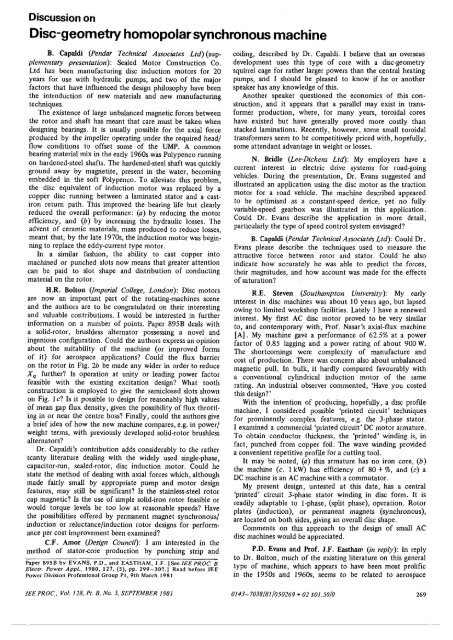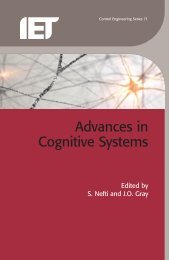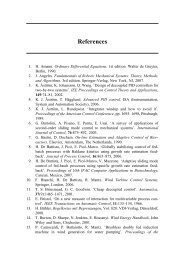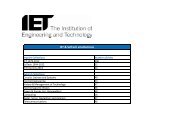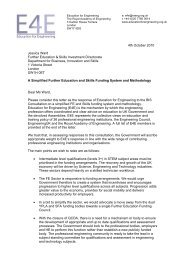Disc-geometry homopolar synchronous machine - IET Digital Library
Disc-geometry homopolar synchronous machine - IET Digital Library
Disc-geometry homopolar synchronous machine - IET Digital Library
Create successful ePaper yourself
Turn your PDF publications into a flip-book with our unique Google optimized e-Paper software.
<strong>Disc</strong>ussion on<br />
<strong>Disc</strong>-<strong>geometry</strong> <strong>homopolar</strong> <strong>synchronous</strong> <strong>machine</strong><br />
B. Capaldi (Pendar Technical Associates Ltd) (supplementary<br />
presentation): Sealed Motor Construction Co.<br />
Ltd has been manufacturing disc induction motors for 20<br />
years for use with hydraulic pumps, and two of the major<br />
factors that have influenced the design philosophy have been<br />
the introduction of new materials and new manufacturing<br />
techniques.<br />
The existence of large unbalanced magnetic forces between<br />
the rotor and shaft has meant that care must be taken when<br />
designing bearings. It is usually possible for the axial force<br />
produced by the impeller operating under the required head/<br />
flow conditions to offset some of the UMP. A common<br />
bearing material mix in the early 1960s was Polypenco running<br />
on hardened-steel shafts. The hardened-steel shaft was quickly<br />
ground away by magnetite, present in the water, becoming<br />
embedded in the soft Polypenco. To alleviate this problem,<br />
the disc equivalent of induction motor was replaced by a<br />
copper disc running between a laminated stator and a castiron<br />
return path. This improved the bearing life but clearly<br />
reduced the overall performance: (a) by reducing the motor<br />
efficiency, and (b) by increasing the hydraulic losses. The<br />
advent of ceramic materials, mass produced to reduce losses,<br />
meant that, by the late 1970s, the induction motor was beginning<br />
to replace the eddy-current type motor.<br />
In a similar fashion, the ability to cast copper into<br />
<strong>machine</strong>d or punched slots now means that greater attention<br />
can be paid to slot shape and distribution of conducting<br />
material on the rotor.<br />
H.R. Bolton (Imperial College, London): <strong>Disc</strong> motors<br />
are now an important part of the rotating-<strong>machine</strong>s scene<br />
and the authors are to be congratulated on their interesting<br />
and valuable contributions. I would be interested in further<br />
information on a number of points. Paper 895B deals with<br />
a solid-rotor, brushless alternator possessing a novel and<br />
ingenious configuration. Could the authors express an opinion<br />
about the suitability of the <strong>machine</strong> (or improved forms<br />
of it) for aerospace applications? Could the flux barrier<br />
on the rotor in Fig. 2b be made any wider in order to reduce<br />
X q further? Is operation at unity or leading power factor<br />
feasible with the existing excitation design? What tooth<br />
construction is employed to give the semiclosed slots shown<br />
on Fig. 1 c? Is it possible to design for reasonably high values<br />
Of mean gap flux density, given the possibility of flux throttling<br />
in or near the centre boss? Finally, could the authors give<br />
a brief idea of how the new <strong>machine</strong> compares, e.g. in power/<br />
weight terms, with previously developed solid-rotor brushless<br />
alternators?<br />
Dr. Capaldi's contribution adds considerably to the rather<br />
scanty literature dealing with the widely used single-phase,<br />
capacitor-run, sealed-rotor, disc induction motor. Could he<br />
state the method of dealing with axial forces which, although<br />
made fairly small by appropriate pump and motor design<br />
features, may still be significant? Is the stainless-steel rotor<br />
cap magnetic? Is the use of simple solid-iron rotor feasible or<br />
would torque levels be too low at reasonable speeds? Have<br />
the possibilities offered by permanent magnet <strong>synchronous</strong>/<br />
induction or reluctance/induction rotor designs for performance<br />
per cost improvement been examined?<br />
C.F. Amor (Design Council): I am interested in the<br />
method of stator-core production by punching strip and<br />
Paper 895B by EVANS, P.D., and EASTHAM, J.F. [See IEEPROC. B<br />
Electr. Power Appl., 1980, 127, (5), pp. 299-307.] Read before IEE<br />
Power Division Professional Group PI, 9th March 1981<br />
coiling, described by Dr. Capaldi. I believe that an overseas<br />
development uses this type of core with a disc-<strong>geometry</strong><br />
squirrel cage for rather larger powers than the central heating<br />
pumps, and I should be pleased to know if he or another<br />
speaker has any knowledge of this.<br />
Another speaker questioned the economics of this construction,<br />
and it appears that a parallel may exist in transformer<br />
production, where, for many years, toroidal cores<br />
have existed but have generally proved more costly than<br />
stacked laminations. Recently, however, some small toroidal<br />
transformers seem to be competitively priced with, hopefully,<br />
some attendant advantage in weight or losses.<br />
N. Bridle (Lee-Dickens Ltd): My employers have a<br />
current interest in electric drive systems for road-going<br />
vehicles. During the presentation, Dr. Evans suggested and<br />
illustrated an application using the disc motor as the traction<br />
motor for a road vehicle. The <strong>machine</strong> described appeared<br />
to be optimised as a constant-speed device, yet no fully<br />
variable-speed gearbox was illustrated in this application.<br />
Could Dr. Evans describe the application in more detail,<br />
particularly the type of speed control system envisaged?<br />
B. Capaldi (Pendar Technical Associated Ltd): Could Dr.<br />
Evans please describe the techniques used to measure the<br />
attractive force between rotor and stator. Could he also<br />
indicate how accurately he was able to predict the forces,<br />
their magnitudes, and how account was made for the effects<br />
of saturation?<br />
R.E. Steven (Southampton University): My early<br />
interest in disc <strong>machine</strong>s was about 10 years ago, but lapsed<br />
owing to limited workshop facilities. Lately I have a renewed<br />
interest. My first AC disc motor proved to be very similar<br />
to, and contemporary with, Prof. Nasar's axial-flux <strong>machine</strong><br />
[A]. My <strong>machine</strong> gave a performance of 62.5% at a power<br />
factor of 0.85 lagging and a power rating of about 900 W.<br />
The shortcomings were complexity of manufacture and<br />
cost of production. There was concern also about unbalanced<br />
magnetic pull. In bulk, it hardly compared favourably with<br />
a conventional cylindrical induction motor of the same<br />
rating. An industrial observer commented, 'Have you costed<br />
this design?'<br />
With the intention of producing, hopefully, a disc profile<br />
<strong>machine</strong>, I considered possible 'printed circuit' techniques<br />
for prominently complex features, e.g. the 3-phase stator.<br />
I examined a commercial 'printed circuit' DC motor armature.<br />
To obtain conductor thickness, the 'printed' winding is, in<br />
fact, punched from copper foil. The wave winding provided<br />
a convenient repetitive profile for a cutting tool.<br />
It may be noted, (a) this armature has no iron core, (b)<br />
the <strong>machine</strong> (c. 1 kW) has efficiency of 80 + %, and (c) a<br />
DC <strong>machine</strong> is an AC <strong>machine</strong> with a commutator.<br />
My present design, untested at this date, has a central<br />
'printed' circuit 3-phase stator winding in disc form. It is<br />
readily adaptable to 1-phase, (split phase), operation. Rotor<br />
plates (induction), or permanent magnets (<strong>synchronous</strong>),<br />
are located on both sides, giving an overall disc shape.<br />
Comments on this approach to the design of small AC<br />
disc <strong>machine</strong>s would be appreciated.<br />
P.D. Evans and Prof. J.F. Eastham (in reply): In reply<br />
to Dr. Bolton, much of the existing literature on this general<br />
type of <strong>machine</strong>, which appears to have been most prolific<br />
in the 1950s and 1960s, seems to be related to aerospace<br />
IEE PROC, Vol. 128, Pt. B, No. 5, SEPTEMBER 1981 0143-7038/81/050269 + 02 $01.50/0 269
applications. The absence of brushes and the solid rotor<br />
has made these <strong>machine</strong>s very suitable for high-speed and<br />
high-frequency operation. It is probably fairer to say, therefore,<br />
that we have been learning from aerospace practice<br />
rather than the other way round.<br />
Some further optimisation of the flux barriers in Fig. 2b<br />
is probably possible, but the gains achieved by increasing<br />
their width become progressively smaller. This is because<br />
the flux path across this barrier is in parallel with a path<br />
through the central boss, via the auxiliary airgap.<br />
The prototype <strong>machine</strong> was designed to operate at a<br />
high lagging power factor. Further improvement of this<br />
power factor, or achievement of a leading power factor<br />
appears to be a matter of applying normal <strong>synchronous</strong><strong>machine</strong><br />
design methods.<br />
The teeth are made from L-shaped laminations, as shown<br />
in Fig. la. The outer three laminations on each side of a<br />
tooth were made longer, and bent to produce the effect of<br />
a tooth tip. A similar effect could probably have been achieved<br />
by the use of saturable wedges.<br />
The main constraint of the possibility of flux throttling<br />
in the centre boss is the total amount of flux that is carried<br />
by it. For a given amount of flux, any reasonable airgap<br />
flux density can be achieved in the airgap, provided that<br />
the core width is adjusted.<br />
The <strong>machine</strong> described is of the <strong>homopolar</strong> variety in that<br />
flux density excursions in the iron core are unidirectional.<br />
It is necessarily, therefore, potentially heavier than conventional<br />
<strong>machine</strong>s of a similar rating. However, its form<br />
of construction is such that it can be run at high speeds —<br />
from a solid-state variable-frequency supply — so that its<br />
power/weight ratio can be considered to be improved by<br />
this means.<br />
In reply to Dr. Capaldi, the attractive forces between<br />
stator and rotor were measured by means of piezoelectric<br />
force transducers and a charge amplifier. Three such transducers<br />
were placed between the base of the stator and its<br />
casing. The theoretical method of predicting these forces,<br />
which is described in the paper, applies the principle of<br />
Maxwell's stresses to a salient-pole <strong>machine</strong> with field<br />
excitation. The axial force is expressed in terms of the d-<br />
and #-axis reactance model of the <strong>machine</strong>. It is therefore<br />
valid so long as the model is valid. Results presented in the<br />
paper (Fig. 9) show that close agreement is achieved for<br />
unsaturated conditions, but that the quality of predictions<br />
deteriorates at higher levels of saturation (Section 5).<br />
Refinements to the method described could probably be<br />
made to improve these predictions, in the same kind of way<br />
that allowances are made in the 2-axis model for the prediction<br />
of torque etc. under saturated conditions. Even as it<br />
stands, however, the model enables relatively reliable force<br />
predictions to be made by simple calculations. It would<br />
be expected that improved calculations could be made using<br />
computer-based methods, but these would be expensive to<br />
implement.<br />
In reply to Dr. Steven, it was interesting to hear of his<br />
own disc-motor activities, and we look forward to hearing the<br />
outcome of his present work.<br />
In reply to Mr. Bridle the disc <strong>machine</strong> described may<br />
be thought of as a <strong>synchronous</strong> <strong>machine</strong> with an unusual<br />
<strong>geometry</strong>. It may, therefore, be incorporated in a drive system<br />
in the same sort of way that a <strong>synchronous</strong> <strong>machine</strong> might<br />
be. Typically, therefore, it could be operated with a variable<br />
frequency controller to give a variable speed output, probably<br />
in conjunction with a gearbox that has discrete speed ratios.<br />
Alternatively, it could be driven at a fixed — and probably<br />
high — speed, with the output being taken through a gearbox<br />
that provides a continuously variable speed ratio.<br />
B. Capaldi (in reply): In reply to Dr. Bolton, in the<br />
pump's designed by Sealed Motor Construction Co. Ltd, it<br />
is possible to ensure that magnetic attraction and hydraulic<br />
repulsion are exactly equal for one load condition. In<br />
practice, effort is made to ensure that some resultant force<br />
is present, and this is catered for by arranging that hydrodynamic<br />
lubrication exists on the appropriate bearing surfaces.<br />
The stainless-steel rotor cap is magnetic and the disc motors<br />
manufactured invariably incorporate solid iron rotors. Other<br />
motor types have only received superficial attention, though<br />
the exarnination has not been restricted to design procedures<br />
alone. The results to date do not suggest any improvements<br />
! in costs; although, as with radial flux <strong>machine</strong>s, exception<br />
undoubtedly exists.<br />
In reply to Mr. Amor, Sealed Motor Construction<br />
Co. Ltd now produce stators by punching the strip and coiling<br />
in the same sequence. Three other firms in Switzerland,<br />
Italy and Australia are known to produce disc motor stators<br />
in a similar way. Specific enquiries in relation to these techniques<br />
should be addressed to the above Company.<br />
On the economics of manufacturing this type of motor/<br />
pump combination, it is difficult to divide the costs. Indeed,<br />
this product is a prime example of the need to suit the motor<br />
design to the local requirements; particularly the type of<br />
load.<br />
References<br />
DC107 B<br />
A NASAR, S.A.: 'An axial airgap, variable speed eddy-current motor',<br />
IEEE Trans., 1968, PAS-87,pp. 1599-1603<br />
270 IEEPROC, Vol. 128, Pt. B, No. 5, SEPTEMBER 1981


